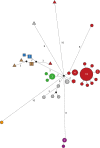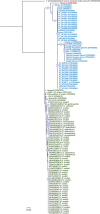Strain diversity of Treponema pallidum subsp. pertenue suggests rare interspecies transmission in African nonhuman primates
- PMID: 31578447
- PMCID: PMC6775232
- DOI: 10.1038/s41598-019-50779-9
Strain diversity of Treponema pallidum subsp. pertenue suggests rare interspecies transmission in African nonhuman primates
Abstract
In our most recent study, we found that in Tanzania infection with Treponema pallidum (TP) subsp. pertenue (TPE) is present in four different monkey species. In order to gain information on the diversity and epidemiological spread of the infection in Tanzanian nonhuman primates (NHP), we identified two suitable candidate genes for multi-locus sequence typing (MLST). We demonstrate the functionality of the MLST system in invasively and non-invasively collected samples. While we were not able to demonstrate frequent interspecies transmission of TPE in Tanzanian monkeys, our results show a clustering of TPE strains according to geography and not host species, which is suggestive for rare transmission events between different NHP species. In addition to the geographic stability, we describe the relative temporal stability of the strains infecting NHPs and identified multi-strain infection. Differences between TPE strains of NHP and human origin are highlighted. Our results show that antibiotic resistance does not occur in Tanzanian TPE strains of NHP origin.
Conflict of interest statement
The authors declare no competing interests.
Figures



References
Publication types
MeSH terms
Supplementary concepts
LinkOut - more resources
Full Text Sources

